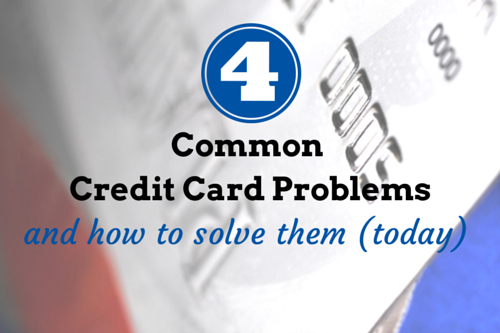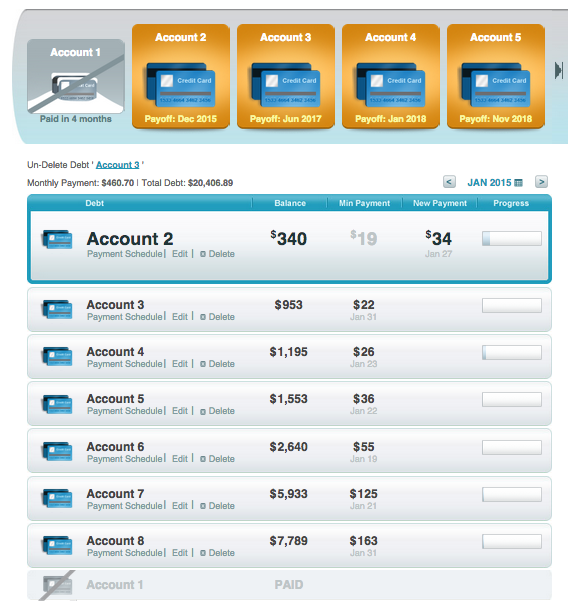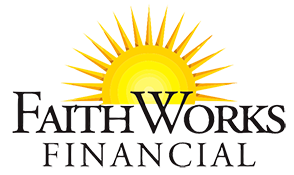4 Common Credit Card Problems And How To Solve Them Today

Credit cards are designed and marketed to be a tool of convenience.
As convenient as they may be, with an estimated 334 million active credit cards in circulation in the US, they sometimes create more problems than they solve.
In our line of work, we hear about those difficulties and struggles every day. There are 4 common credit card problems that we most often hear about, and we thought we’d put together a definitive guide on how you can begin to solve each of them today.
To help you, we’ve created a free checklist outlining the steps to solve each credit card problem. Click Here for your free checklist. Got it? Let’s get to it!
Credit Card Problem #1- I Have Too Many Credit Cards
Americans have an average of 2.19 cards in their wallet. The average number of accounts held by FaithWorks Financial debt settlement clients is 6.3. It isn’t conclusive, but this might indicate that holding too many accounts can lead to financial difficulties. In addition to being a higher risk for trouble ahead, having too many credit cards adds complication to your life. “Which one do I use to get the gas points?”
“Which one is close to the limit?”
“This is a big purchase- which one has the best rate?”
These might be small and minor questions to ask in the moment, but we all have enough on our mind as it is. No need to add more things for your brain to sort through.
The Solution
Fortunately, this common credit card problem has two relatively easy fixes. Once you go through them, be sure to hop down to #4 to fix the bigger issue on this one.
Consolidate Them Yourself
While you should really look at the underlying reason that you have so many cards in the first place, the quick solution for this is to consolidate your accounts.
If you have one credit card with a high limit and (hopefully) a low interest rate, transfer as many of the small balances onto that account as you can without going too close to the credit limit. Ideally, you should leave at least 20% of the limit open to show responsible use of your available credit. If that isn’t possible do not let it stop you. It is better to have a low credit score problem than an unmanageable debt problem.
[Tweet “It is better to have a low credit score problem than an unmanageable debt problem. “]
Going from 6 accounts to 1, or 10 accounts to 2 will make things much more manageable and help prevent confusion leading to costly missed payments.
Snowball It
This one will take a bit more time, but the snowball method is a proven way to pay off your debts from the smallest to the largest. Since you are prioritizing by balance instead of interest rates, you will see accounts paid off more quickly.

There is a really great tool available on Dave Ramsey’s website that let’s you plug all of your figures in and tells you exactly when each account will be paid. It calculates interest, minimum payments and extra payments. Here’s an example of the snowball method in action, using their free tool.
Credit Card Problem #2- I Cosigned For Someone Other Than My Spouse
Cosigning loans is one of the most common credit card problems that we hear about that leads directly to further financial difficulties. Many of the people that are considering our debt relief programs are in the position partly as a result of having cosigned in the past.
Maybe you cosigned for a child’s student loans or for a friend when they couldn’t get a needed loan on their own. Whatever the reason, cosigning for someone other than your spouse can lead to murky water between friends and family.
If you’ve co-signed and the individual defaults on the account, your good credit is at risk. You probably understood that was a possibility at the time, but as soon as you can reduce your liability you should. Not only is your relationship with the individual at risk, but this item or line of credit is doing a dance on your credit report too. It is factored in to your debt to income ratio, your number of open accounts and your overall credit history, all of which play a role in determining your credit score.
The Solution
This one isn’t always as easy to solve, but with a bit of work you should be able to have your name off of the account as early as today.
Request a Cosigner Release
Contact the lender and notify them that you would like to complete a “cosigner release”. This process effectively releases your liability from the loan. They may have certain requirements to complete this, such as a certain number of payments having been made, a recheck of the primary borrowers credit score, or the balance being paid down below a certain threshold.
If it means you have to help the individual meet those requirements by paying down the balance a bit, consider the cost benefit. Paying $250 to get your name off of there this would be wise use of your money. On the other hand, $5,000 might not be as simple of a decision.
Refinance Out Of The Situation
If the cosigner release was unsuccessful you or the primary borrower can do a bit of a credit dance. This is not something that is advised for someone trying to get out of debt, but it can be an effective way to limit the liability from cosigning.
Let’s say the loan that was cosigned was a $3,000 loan, and there is a balance left of $2,000. The individual who benefited from the loan can apply for a new loan (or credit card if the balance is low enough) and transfer the balance due on the other account.They may need to open up two lines of credit or use cash reserves to make this a possibility.
As far as dollars and cents are concerned, this is not going to be the most cost effective method for the person opening the new accounts, but it can serve it’s purpose.
If these are student loans, a student loan consolidation or refinance (solely in the students name) could be a much better move to have the cosigner removed. Just don’t combine Federal and Private student loans into all private, otherwise a lot of helpful benefits are lost.
[Tweet “Cosigning- all risk and no reward. Here’s how get your name off that loan.”]
Credit Card Problem #3- My Interest Rates Are Too High
According to Bankrates weekly credit card interest rate round-up, the average interest rate in January 2024 is 20.74% for variable rates. Up about 7% from when this article was originally written in 2014! Using the credit card payoff calculator, we see that paying the minimum payment on a $20,000 account with 20.74% interest will take almost 10 years and cost $26,601 in interest.

If you’ve ever missed a payment, you may have witnessed your credit card interest rate jump up to the dreaded 29.99% APR. Many of the folks we speak with have cards with longstanding default interest rates. The calculator wouldn’t even calculate it at the standard minimum payment of 2% of the accounts balance. We had to change the minimum payment to raise the minimum payment from 2% of the balance to 2.5% of the account balance.
Here’s the unsightly breakdown:

Clearly, that’s a problem. So, what to do about it?
The Solution
We’re going to break this down into two groups. The first is anyone who has an average credit card interest rate of 13% or lower OR disposable savings equal to 30% of the total balances (regardless of the credit cards interest rate). The second group is anyone with an interest rate of 13% or higher and does not have that savings available to them.
Group 1- Arrange reduced interest rates and accelerate your repayment
It may come as a surprise, but may be able to arrange reductions of your interest rates on your own, without the assistance of a credit counseling company to help you.
Contact your creditors one by one and let them know that you are experiencing a financial hardship and (if you feel it is an honest statement) that you are afraid you might default in the near future if you cannot get things in a more manageable position. Ask them if they offer any hardship programs for their customers or if there is any way for you to reduce your interest rate to lessen the burden.
In our experience- it’s a coin toss. If you toss the coin enough times, you’ll eventually call it right.
Use the savings you have in reserves to maximize the benefit of this process. Don’t totally give up your emergency fund, but capitalize on the opportunity you have been given.
If you have 3 credit cards and only one will reduce your rate- pay as much as you can on that account to maximize your savings. Keep calling the others every few weeks to ask if they can help.
Group 2- Get Some Help
If your interest rates are over 13% and you do not have a savings built up, you would be wise to look for some outside help.
Yes, you can try the above step to consolidate on your own, but it’s unlikely that all of your creditors are going to offer assistance. With high rates and little savings to fall back on, you’re one missed payment away from financial disaster.
We suggest exploring various debt relief options. While all programs will have pro’s and con’s, some programs are available that will have a minimal impact on your credit score, if any. Depending on the state you live in and other particulars, you may reduce your interest rates, negotiate a settlement of the principal balance, or consider a Christian debt consolidation loan.
Get a FREE debt relief consultation today!
Credit Card Problem #4- I Open Credit Cards Too Impulsively
Now we’re getting to the real causes of the other problems. The above problems are very often the result of this.


(Be sure to keep on reading if you tried to click on either of those.)
These ads are offering an incentive to open their credit cards.
We are constantly screamed at by marketers to open up new lines of credit. What should be a well-thought-out decision has become an impulse for many.
[Tweet “Credit card promos turn what should be a well thought decision into an impulse decision. Here’s how to conquer the impulse. “]
The Solution
Can’t keep yourself (or your spouse) from opening up a new credit card every time you step foot in a shopping mall? This one is surprisingly easy.
Perform a credit freeze.
One of the most surefire solutions of our entire list, a credit freeze is a way to prevent new accounts from being opened. You can go to each of the credit bureaus online and follow their steps to perform the freeze. This action totally prevents a lender from accessing your credit, effectively eliminating their ability to extend you credit.
There used to be a cost to do this; usually about $5 per bureau depending on the state, but most bureaus are now offering free options for a credit freeze. Here is where to start for each:
Don’t worry, it isn’t permanent. You can call anytime to request a temporary “thaw”, or you can lift the freeze entirely.
It isn’t common but read the fine print to make sure you’re aware of any fees for the thaw as well. Those they’ve mostly done away with the fees for these processes, don’t shy away if there is a small fee. It may make it a more effective solution if applying for credit impulsively is an issue in your finances. If you have to pay to lift it, you’ll think a bit more about whether or not you really need to open that line of credit.
A credit freeze is tremendously helpful in preventing identity theft and can be worthwhile even if you manage your credit cards like an all-star. Aren’t planning on opening a new line of credit anytime soon? It could be well worth $5-$10 for the peace of mind knowing that nobody can open anything in your name.
Summing It All Up
Managing credit card debt and avoiding financial pitfalls requires a combination of personal diligence, strategic planning, and sometimes, external assistance. Whether you’re negotiating lower interest rates on your own or seeking professional help to consolidate or settle debts, the key is taking proactive steps toward financial stability. If the hurdles of high interest rates and impulsive credit card usage seem too daunting to overcome alone, remember that help is available.
Get a FREE debt relief consultation from FaithWorks Financial today and take the first step towards regaining control of your financial health. Together, we can find a solution that works for you.
